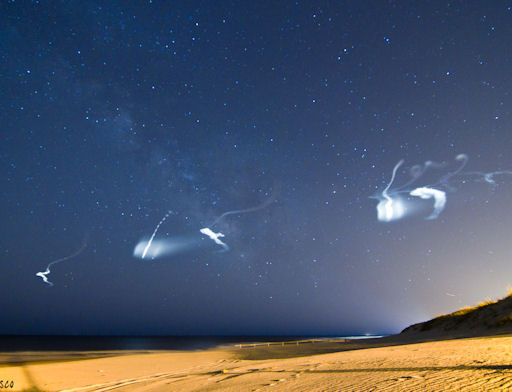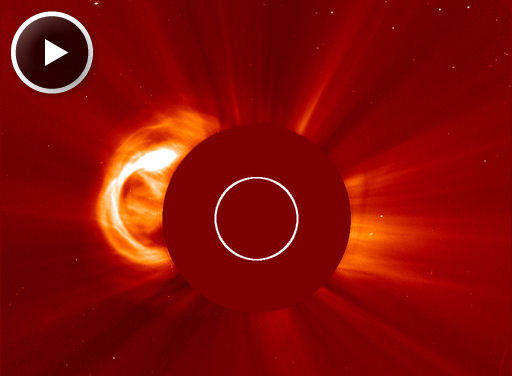GEOMAGNETIC OUTLOOK: NOAA forecasters estimate a 30% to 45% chance of strong geomagnetic storms around the poles on March 28-29 in response to an incoming solar wind stream. High-latitude sky watchers should be alert for auroras. Aurora alerts: text, phone.
ATREX EXPERIMENT LIGHTS UP THE NIGHT SKY: Before sunrise on March 27th, sky watchers up and down the eastern seaboard of the United States witnessed a strange apparition. A quintet of milky-white plumes appeared in the night sky, twisting in the winds at the edge of space. "It was pretty unreal and very exciting to see," says eye-witness Jack Fusco, who sends this picture from Seaside Park in New Jersey:
The plumes were chemical tracers (trimethyl aluminum) deposited in the upper reaches of Earth's atmosphere by five rockets launched rapid-fire from NASA's Wallops Flight Facility in Virginia. The goal of the experiment, named ATREX (Anomalous Transport Rocket Experiment), is to study 3D turbulence in the thermosphere.
"We saw the rockets lift off and then slowly release their chemicals, creating trails in the sky," reports Alice B. of Loudoun County, Virginia. "We could also see what I assume were the rocket remnants falling back to Earth."
"Once the chemical tracers from the rockets were released, the view was amazing," adds Bryan Lauber of Frenchtown, NJ. "The tracers were extremely bright and seemed to just fall out of the sky!"
more images: from Jeff Berkes of West Chester, PA; from Mark A. Brown of Carlisle, PA; from Robert T. Smith of Stoneville, NC; from Rich McPeters near Annapolis, Maryland; from Cliff Baldwin of Aquebogue, NY
ANOTHER CME FROM SUNSPOT AR1429: Transiting the farside of the sun, never-say-die sunspot AR1429 erupted during the late hours of March 26th, producing its 11th major CME. The Solar and Heliospheric Observatory (SOHO) photographed the cloud flying over the sun's eastern limb:
According to a forecast track prepared by analysts at the Goddard Space Weather Lab, the CME will hit two spacecraft, STEREO-B and Spitzer, on March 28th. Earth is not in the line of fire.
This event shows that AR1429, the source of several strong geomagnetic storms in early March, is still active. It will begin turning back toward our planet about a week from now. Stay tuned.

![]()
Solar wind
speed: 355.8 km/sec
density: 11.0 protons/cm3
explanation | more data
Updated: Today at 1626 UT
![]()
X-ray Solar Flares
6-hr max: B6 1136 UT Mar27
24-hr: C5 0308 UT Mar27
explanation | more data
Updated: Today at: 1600 UT
![]()
![]()
![]()
Daily Sun: 27 Mar 12
![]()
![]()
None of these sunspots pose a threat for strong solar flares. Credit: SDO/HMI
![]()
![]()
![]()
Sunspot number: 56
What is the sunspot number?
Updated 25 Mar 2012
Spotless Days
Current Stretch: 0 days
2012 total: 0 days (0%)
2011 total: 2 days (<1%)
2010 total: 51 days (14%)
2009 total: 260 days (71%)
Since 2004: 821 days
Typical Solar Min: 486 days
Updated 25 Mar 2012
The Radio Sun
10.7 cm flux: 101 sfu
explanation | more data
Updated 25 Mar 2012
![]()
![]()
![]()
Current Auroral Oval:
![]()
Switch to: Europe, USA, New Zealand, Antarctica
Credit: NOAA/POES
![]()
![]()
![]()
Planetary K-index
Now: Kp= 3 quiet
24-hr max: Kp= 3 quiet
explanation | more data
![]()
Interplanetary Mag. Field
Btotal: 7.9 nT
Bz: 6.3 nT south
explanation | more data
Updated: Today at 1626 UT
![]()
![]()
![]()
Coronal Holes: 26 Mar 12
![]()
![]()
A solar wind stream flowing from the indicated coronal hole could reach Earth at the end of March. Credit: SDO/AIA.






